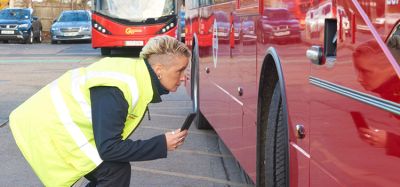New IT challenges in public transportation
- Like
- Digg
- Del
- Tumblr
- VKontakte
- Buffer
- Love This
- Odnoklassniki
- Meneame
- Blogger
- Amazon
- Yahoo Mail
- Gmail
- AOL
- Newsvine
- HackerNews
- Evernote
- MySpace
- Mail.ru
- Viadeo
- Line
- Comments
- Yummly
- SMS
- Viber
- Telegram
- Subscribe
- Skype
- Facebook Messenger
- Kakao
- LiveJournal
- Yammer
- Edgar
- Fintel
- Mix
- Instapaper
- Copy Link
Posted: 6 October 2007 | Anders Kåbjörn, InformNorden Secretary General | No comments yet
The breakthrough of the Internet and the mobile phone in the middle of the 90s made it possible to develop different advanced information services in public transportation…
In order to co-ordinate this development in the Nordic countries, the public transport authorities in the capitals of Sweden, Denmark, Norway and Finland started InformNorden; an open community for people in the Nordic countries interested in making public transport more attractive and efficient by using information technology.
Now, ten years later, we ask ourselves what new IT challenges we are going to meet in public transportation. This is also the theme of the recent ninth international InformNorden conference in Oslo. The conference was a success; many new ideas were born and some of them have also been identified as different realistic IT challenges within the field of organisation, passenger information, marketing and ticketing.
Data sharing in public transportation – a future challenge
Virtual Enterprise is an organisational form characterised by a temporary or permanent collection of geographically dispersed individuals, groups or organisation departments not belonging to the same organisation; or entire organisations that are dependent on electronic communication for carrying out their production process.
“Public Transport is becoming a Virtual Enterprise,” said Stefan Fjällemark, Hogia Public Transport systems. He referred to the experience of new organisational structures; de-regulation in the United Kingdom with free access to the market, compared to controlled competition in Sweden and Denmark with clear roles for transport authorities and operators.
An overview of different types of data sharing between tendering transport authorities and bidding operators was presented. Fjällemark pointed out three ways to achieve acceptance of data sharing; each one a challenge. They involve the design and implementation of:
- Overall strategy and guidelines for passenger information strategy.
- Business model that stimulates co-operation between operators and transport authorities.
- Technical strategy for system integration that supports the information strategy and the business model.
Standards for buses and on-board equipment – an important challenge
The Swedish Bus & Coach Federation has around 400 member companies, 11,000 buses and coaches, and 20,000 employees; in all, 90 percent of the total industry. Fredrik Gustavsson, Head of Regular Services at the Foundation said; “Transport authorities and operators must co-operate on better solutions for the future.” He declared that the overall issue is to increase the public transport market share and the only possible way to achieve this is to wake-up the politicians, create common marketing operations, and reduce costs. “We are working in a very small market, we cannot afford to invent and develop everything ourselves. We must co-operate, and co-operation needs participation from the public transport authorities and suppliers,” added Gustavsson.
In Sweden, there are 21 public transport authorities and 290 municipalities and they all have different requirements. Therefore, we need standards for buses and on-board equipment. This is the topic of a new project carried out in co-operation with the Swedish Public Transport Association.
Performance based sub-contracting – an interesting challenge
Sören Englund, Contract Manager at Movia Public Transport presented a model of sub-contracting based on performance. In a pilot project in Denmark these ideas are tested using the A-bus real-time system in Copenhagen. One A-bus route is used to pay the operator according to the performance. The intentions are to develop a new way of co-operation, to make the most of the benefits from the new IT-system, to leave more responsibility to the operator, and to give the operator an incentive towards the driver in that a part of the payment to the operator is dependant upon the registrations in the A-BIT-system. Englund declared that Movia is in a process with Arriva of re-scheduling the project. We now have to decide whether we will introduce this model to the other A-bus-routes.
Fast broadband and accurate GPS positioning – a technical real-time challenge
Mikko Lehmuskoski, WSP Finland Ltd and Project Manager of the pilot project Fast Broadband and Accurate GPS Positioning in Helsinki, presented new real-time services achieved by buses and trams equipped with broadband services that transmit their locations to the system once per second.
- Real-time services. The position of all vehicles is updated every second. Predicted stop times for vehicles, departure times for any stop, and public web services are built on top of Google Maps.
- Traffic light priorities. Priority is achieved by a server tracking all vehicles. Essentially, vehicles are ‘dumb’ and do not participate in requesting or receiving priorities. When the server notices that a vehicle passes a priority request point on the map, a signal is sent to the according signal controller. Editing signal priority points is carried out on a web interface, and any changes made are effective immediately.
- Services for operators. Position, speed and direction of all vehicles are stored every second. This means that the route of any vehicle can be viewed later, as well as the exact speed and time taken for any point on the route. This is useful in determining if a particular route was late or not driven at all.
Advanced Travel Planners – ongoing travel information challenges
“Holland´s door-to-door travel planner is going multi-modal,” said Hans van Veen, Commercial Manager, REISinformatiegroep, Utrecht, Holland. The challenge is to tailor the travel planner to suit the needs of all travellers and to influence travellers that are willing to make a choice between their car and public transport.
Ed Parson, Geospatial Technologist of Google talked about Google Transit; a worldwide travel planner for public transport, what the plans are, and how it will work. Google’s simple refined mission is to geographically organise the world’s information and make it universally accessible and useful. Google Transit labs have now started to integrate public transport routing with Google Maps, but existing journey planners will not be replaced, said Parson.
Customer needs and user experiences – challenges in the development of passenger information services
Pernille Jörgensen, Marketing Manager, Movia Public Transport, Denmark talked about customer needs and expectations of user friendly and intelligent passenger traffic information. She asked; ‘Do customer needs rather than new technological possibilities drive our development of traffic information services?’ Sara Kalantari, University of Oslo talked about how to improve the user experience of passenger information on the Internet and mobile terminals, and presented her research project; User Experience with Real Time Passenger Information. Oslo has had a successful citywide real time passenger information system in operation for some time. However, there is a low usage of the WAP real time information service via mobile phone. Is this due to costs, complexity, or lack of awareness? Indeed, is there a need to evaluate the need?
“Standards help systems progress towards plug and play,” said Roger Slevin, Standards Manager, Transport Direct, Department for Transport, London, in a very comprehensive presentation of standards in public transportation. “Plug and play is a phrase which has only recently come into use,” he said. “Compared with a television, technical standards control what is in the television set. Technical standards control what the broadcaster transmits. A trust model exists between broadcaster and listener. They both have to agree to use the same standards and each assumes the other will do so, too.” So who wants to plug and play?
- The consumer. Use the same card and the same rules.
- The transport operator. The ability to move equipment between vehicles.
- Back office system operators. Consistency and robustness of data, security, and licence documentation.
- The ticket machine manufacturer. One product range for many different systems.
Related topics
Business Models, Fleet Management & Maintenance, Intelligent Transport Systems (ITS), Multimodality, Ticketing & Payments, Transport Governance & Policy
Issue
Issue 5 2007
Related organisations
InformNorden
Related people
Anders Kåbjörn








